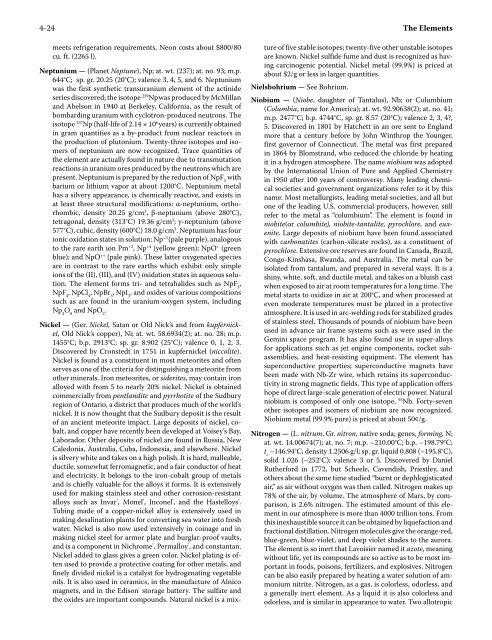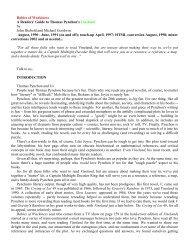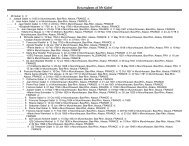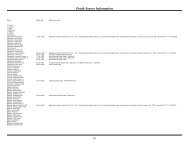CRC Handbook of Chemistry and Physics, 86th Edition
CRC Handbook of Chemistry and Physics, 86th Edition
CRC Handbook of Chemistry and Physics, 86th Edition
Create successful ePaper yourself
Turn your PDF publications into a flip-book with our unique Google optimized e-Paper software.
4-24 The Elements<br />
meets refrigeration requirements. Neon costs about $800/80<br />
cu. ft. (2265 l).<br />
Neptunium — (Planet Neptune), Np; at. wt. (237); at. no. 93; m.p.<br />
644°C; sp. gr. 20.25 (20°C); valence 3, 4, 5, <strong>and</strong> 6. Neptunium<br />
was the first synthetic transuranium element <strong>of</strong> the actinide<br />
series discovered; the isotope 239 Np was produced by McMillan<br />
<strong>and</strong> Abelson in 1940 at Berkeley, California, as the result <strong>of</strong><br />
bombarding uranium with cyclotron-produced neutrons. The<br />
isotope 237 Np (half-life <strong>of</strong> 2.14 × 10 6 years) is currently obtained<br />
in gram quantities as a by-product from nuclear reactors in<br />
the production <strong>of</strong> plutonium. Twenty-three isotopes <strong>and</strong> isomers<br />
<strong>of</strong> neptunium are now recognized. Trace quantities <strong>of</strong><br />
the element are actually found in nature due to transmutation<br />
reactions in uranium ores produced by the neutrons which are<br />
present. Neptunium is prepared by the reduction <strong>of</strong> NpF 3 with<br />
barium or lithium vapor at about 1200°C. Neptunium metal<br />
has a silvery appearance, is chemically reactive, <strong>and</strong> exists in<br />
at least three structural modifications: α-neptunium, orthorhombic,<br />
density 20.25 g/cm 3 , β-neptunium (above 280°C),<br />
tetragonal, density (313°C) 19.36 g/cm 3 ; γ-neptunium (above<br />
577°C), cubic, density (600°C) 18.0 g/cm 3 . Neptunium has four<br />
ionic oxidation states in solution: Np +3 (pale purple), analogous<br />
to the rare earth ion Pm +3 , Np +4 (yellow green); NpO + (green<br />
blue); <strong>and</strong> NpO ++ (pale pink). These latter oxygenated species<br />
are in contrast to the rare earths which exhibit only simple<br />
ions <strong>of</strong> the (II), (III), <strong>and</strong> (IV) oxidation states in aqueous solution.<br />
The element forms tri- <strong>and</strong> tetrahalides such as NpF 3 ,<br />
NpF 4 , NpCl 4 , NpBr 3 , NpI 3 , <strong>and</strong> oxides <strong>of</strong> various compositions<br />
such as are found in the uranium-oxygen system, including<br />
Np 3 O 8 <strong>and</strong> NpO 2 .<br />
Nickel — (Ger. Nickel, Satan or Old Nick’s <strong>and</strong> from kupfernickel,<br />
Old Nick’s copper), Ni; at. wt. 58.6934(2); at. no. 28; m.p.<br />
1455°C; b.p. 2913°C; sp. gr. 8.902 (25°C); valence 0, 1, 2, 3.<br />
Discovered by Cronstedt in 1751 in kupfernickel (niccolite).<br />
Nickel is found as a constituent in most meteorites <strong>and</strong> <strong>of</strong>ten<br />
serves as one <strong>of</strong> the criteria for distinguishing a meteorite from<br />
other minerals. Iron meteorites, or siderites, may contain iron<br />
alloyed with from 5 to nearly 20% nickel. Nickel is obtained<br />
commercially from pentl<strong>and</strong>ite <strong>and</strong> pyrrhotite <strong>of</strong> the Sudbury<br />
region <strong>of</strong> Ontario, a district that produces much <strong>of</strong> the world’s<br />
nickel. It is now thought that the Sudbury deposit is the result<br />
<strong>of</strong> an ancient meteorite impact. Large deposits <strong>of</strong> nickel, cobalt,<br />
<strong>and</strong> copper have recently been developed at Voisey’s Bay,<br />
Laborador. Other deposits <strong>of</strong> nickel are found in Russia, New<br />
Caledonia, Australia, Cuba, Indonesia, <strong>and</strong> elsewhere. Nickel<br />
is silvery white <strong>and</strong> takes on a high polish. It is hard, malleable,<br />
ductile, somewhat ferromagnetic, <strong>and</strong> a fair conductor <strong>of</strong> heat<br />
<strong>and</strong> electricity. It belongs to the iron-cobalt group <strong>of</strong> metals<br />
<strong>and</strong> is chiefly valuable for the alloys it forms. It is extensively<br />
used for making stainless steel <strong>and</strong> other corrosion-resistant<br />
alloys such as Invar ® , Monel ® , Inconel ® , <strong>and</strong> the Hastelloys ® .<br />
Tubing made <strong>of</strong> a copper-nickel alloy is extensively used in<br />
making desalination plants for converting sea water into fresh<br />
water. Nickel is also now used extensively in coinage <strong>and</strong> in<br />
making nickel steel for armor plate <strong>and</strong> burglar-pro<strong>of</strong> vaults,<br />
<strong>and</strong> is a component in Nichrome ® , Permalloy ® , <strong>and</strong> constantan.<br />
Nickel added to glass gives a green color. Nickel plating is <strong>of</strong>ten<br />
used to provide a protective coating for other metals, <strong>and</strong><br />
finely divided nickel is a catalyst for hydrogenating vegetable<br />
oils. It is also used in ceramics, in the manufacture <strong>of</strong> Alnico<br />
magnets, <strong>and</strong> in the Edison ® storage battery. The sulfate <strong>and</strong><br />
the oxides are important compounds. Natural nickel is a mix-<br />
ture <strong>of</strong> five stable isotopes; twenty-five other unstable isotopes<br />
are known. Nickel sulfide fume <strong>and</strong> dust is recognized as having<br />
carcinogenic potential. Nickel metal (99.9%) is priced at<br />
about $2/g or less in larger quantities.<br />
Nielsbohrium — See Bohrium.<br />
Niobium — (Niobe, daughter <strong>of</strong> Tantalus), Nb; or Columbium<br />
(Columbia, name for America); at. wt. 92.90638(2); at. no. 41;<br />
m.p. 2477°C; b.p. 4744°C, sp. gr. 8.57 (20°C); valence 2, 3, 4?,<br />
5. Discovered in 1801 by Hatchett in an ore sent to Engl<strong>and</strong><br />
more that a century before by John Winthrop the Younger,<br />
first governor <strong>of</strong> Connecticut. The metal was first prepared<br />
in 1864 by Blomstr<strong>and</strong>, who reduced the chloride by heating<br />
it in a hydrogen atmosphere. The name niobium was adopted<br />
by the International Union <strong>of</strong> Pure <strong>and</strong> Applied <strong>Chemistry</strong><br />
in 1950 after 100 years <strong>of</strong> controversy. Many leading chemical<br />
societies <strong>and</strong> government organizations refer to it by this<br />
name. Most metallurgists, leading metal societies, <strong>and</strong> all but<br />
one <strong>of</strong> the leading U.S. commercial producers, however, still<br />
refer to the metal as “columbium”. The element is found in<br />
niobite(or columbite), niobite-tantalite, pyrochlore, <strong>and</strong> euxenite.<br />
Large deposits <strong>of</strong> niobium have been found associated<br />
with carbonatites (carbon-silicate rocks), as a constituent <strong>of</strong><br />
pyrochlore. Extensive ore reserves are found in Canada, Brazil,<br />
Congo-Kinshasa, Rw<strong>and</strong>a, <strong>and</strong> Australia. The metal can be<br />
isolated from tantalum, <strong>and</strong> prepared in several ways. It is a<br />
shiny, white, s<strong>of</strong>t, <strong>and</strong> ductile metal, <strong>and</strong> takes on a bluish cast<br />
when exposed to air at room temperatures for a long time. The<br />
metal starts to oxidize in air at 200°C, <strong>and</strong> when processed at<br />
even moderate temperatures must be placed in a protective<br />
atmosphere. It is used in arc-welding rods for stabilized grades<br />
<strong>of</strong> stainless steel. Thous<strong>and</strong>s <strong>of</strong> pounds <strong>of</strong> niobium have been<br />
used in advance air frame systems such as were used in the<br />
Gemini space program. It has also found use in super-alloys<br />
for applications such as jet engine components, rocket subassemblies,<br />
<strong>and</strong> heat-resisting equipment. The element has<br />
superconductive properties; superconductive magnets have<br />
been made with Nb-Zr wire, which retains its superconductivity<br />
in strong magnetic fields. This type <strong>of</strong> application <strong>of</strong>fers<br />
hope <strong>of</strong> direct large-scale generation <strong>of</strong> electric power. Natural<br />
niobium is composed <strong>of</strong> only one isotope, 93Nb. Forty-seven<br />
other isotopes <strong>and</strong> isomers <strong>of</strong> niobium are now recognized.<br />
Niobium metal (99.9% pure) is priced at about 50¢/g.<br />
Nitrogen — (L. nitrum, Gr. nitron, native soda; genes, forming, N;<br />
at. wt. 14.00674(7); at. no. 7; m.p. –210.00°C; b.p. –198.79°C;<br />
t c –146.94°C; density 1.2506 g/l; sp. gr. liquid 0.808 (–195.8°C),<br />
solid 1.026 (–252°C); valence 3 or 5. Discovered by Daniel<br />
Rutherford in 1772, but Scheele, Cavendish, Priestley, <strong>and</strong><br />
others about the same time studied “burnt or dephlogisticated<br />
air,” as air without oxygen was then called. Nitrogen makes up<br />
78% <strong>of</strong> the air, by volume. The atmosphere <strong>of</strong> Mars, by comparison,<br />
is 2.6% nitrogen. The estimated amount <strong>of</strong> this element<br />
in our atmosphere is more than 4000 trillion tons. From<br />
this inexhaustible source it can be obtained by liquefaction <strong>and</strong><br />
fractional distillation. Nitrogen molecules give the orange-red,<br />
blue-green, blue-violet, <strong>and</strong> deep violet shades to the aurora.<br />
The element is so inert that Lavoisier named it azote, meaning<br />
without life, yet its compounds are so active as to be most important<br />
in foods, poisons, fertilizers, <strong>and</strong> explosives. Nitrogen<br />
can be also easily prepared by heating a water solution <strong>of</strong> ammonium<br />
nitrite. Nitrogen, as a gas, is colorless, odorless, <strong>and</strong><br />
a generally inert element. As a liquid it is also colorless <strong>and</strong><br />
odorless, <strong>and</strong> is similar in appearance to water. Two allotropic







